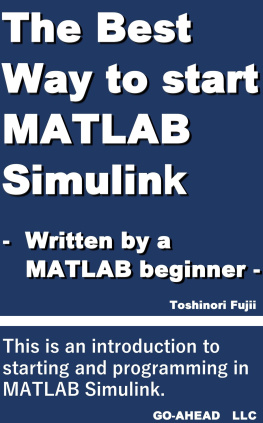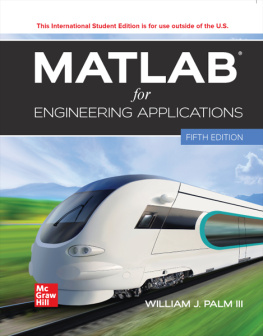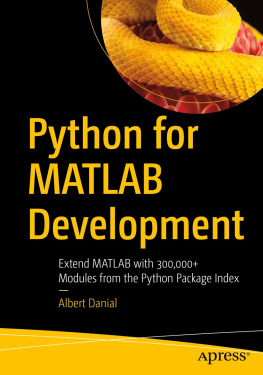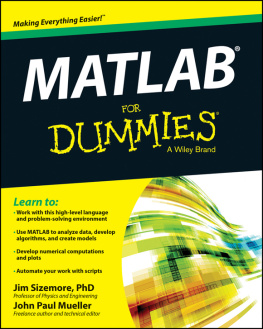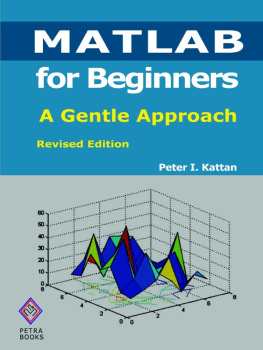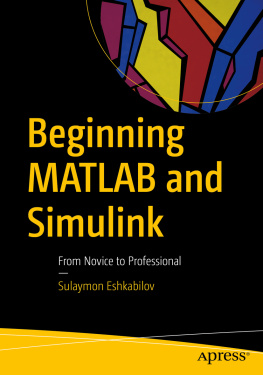Stormy Attaway - MATLAB
Here you can read online Stormy Attaway - MATLAB full text of the book (entire story) in english for free. Download pdf and epub, get meaning, cover and reviews about this ebook. year: 2016, publisher: Elsevier Inc., genre: Children. Description of the work, (preface) as well as reviews are available. Best literature library LitArk.com created for fans of good reading and offers a wide selection of genres:
Romance novel
Science fiction
Adventure
Detective
Science
History
Home and family
Prose
Art
Politics
Computer
Non-fiction
Religion
Business
Children
Humor
Choose a favorite category and find really read worthwhile books. Enjoy immersion in the world of imagination, feel the emotions of the characters or learn something new for yourself, make an fascinating discovery.

- Book:MATLAB
- Author:
- Publisher:Elsevier Inc.
- Genre:
- Year:2016
- Rating:4 / 5
- Favourites:Add to favourites
- Your mark:
- 80
- 1
- 2
- 3
- 4
- 5
MATLAB: summary, description and annotation
We offer to read an annotation, description, summary or preface (depends on what the author of the book "MATLAB" wrote himself). If you haven't found the necessary information about the book — write in the comments, we will try to find it.
MATLAB — read online for free the complete book (whole text) full work
Below is the text of the book, divided by pages. System saving the place of the last page read, allows you to conveniently read the book "MATLAB" online for free, without having to search again every time where you left off. Put a bookmark, and you can go to the page where you finished reading at any time.
Font size:
Interval:
Bookmark:
Fourth Edition
Stormy Attaway
Department of Mechanical Engineering, Boston University

Butterworth-Heinemann is an imprint of Elsevier
The Boulevard, Langford Lane, Kidlington, Oxford OX5 1GB, UK
50 Hampshire Street, 5th Floor, Cambridge, MA 02139, USA
First published 2009
Second edition 2012
Third edition 2013
Fourth edition 2017
2017 Elsevier Inc. All rights reserved.
No part of this publication may be reproduced or transmitted in any form or by any means, electronic or mechanical, including photocopying, recording, or any information storage and retrieval system, without permission in writing from the publisher. Details on how to seek permission, further information about the Publishers permissions policies and our arrangements with organizations such as the Copyright Clearance Center and the Copyright Licensing Agency, can be found at our website: www.elsevier.com/permissions.
This book and the individual contributions contained in it are protected under copyright by the Publisher (other than as may be noted herein).
Notices
Knowledge and best practice in this field are constantly changing. As new research and experience broaden our understanding, changes in research methods, professional practices, or medical treatment may become necessary.
Practitioners and researchers must always rely on their own experience and knowledge in evaluating and using any information, methods, compounds, or experiments described herein. In using such information or methods they should be mindful of their own safety and the safety of others, including parties for whom they have a professional responsibility.
To the fullest extent of the law, neither the Publisher nor the authors, contributors, or editors, assume any liability for any injury and/or damage to persons or property as a matter of products liability, negligence or otherwise, or from any use or operation of any methods, products, instructions, or ideas contained in the material herein.
MATLAB is a registered trademark of The MathWorks, Inc., and is used with permission.
Library of Congress Cataloging-in-Publication Data
A catalog record for this book is available from the Library of Congress
British Library Cataloguing-in-Publication Data
A catalogue record for this book is available from the British Library
ISBN: 978-0-12-804525-1
For information on all Butterworth-Heinemann publications visit our website at https://www.elsevier.com/

Publisher: Todd Green
Acquisition Editor: Stephen Merken
Developmental Editor: Nate McFadden
Production Project Manager: Sujatha Thirugnana Sambandam
Cover Designer: Greg Harris
Typeset by SPi Global, India
This book is dedicated to all of my family: my mother Jane Conklin, my sister Catherine Attaway, my brother Banks Attaway, my stepmother Robyn Attaway, and my husband Ted de Winter.
The purpose of this book is to teach basic programming concepts and skills needed for basic problem solving, all using MATLAB as the vehicle. MATLAB is a powerful software package that has built-in functions to accomplish a diverse range of tasks, from mathematical operations to three-dimensional imaging. Additionally, MATLAB has a complete set of programming constructs that allow users to customize programs to their own specifications.
There are many books that introduce MATLAB. There are two basic flavors of these books: those that demonstrate the use of the built-in functions in MATLAB, with a chapter or two on some programming concepts, and those that cover only the programming constructs without mentioning many of the built-in functions that make MATLAB efficient to use. Someone who learns just the built-in functions will be well-prepared to use MATLAB, but would not understand basic programming concepts. That person would not be able to then learn a language such as C++ or Java without taking another introductory course, or reading another book, on the programming concepts. Conversely, anyone who learns only programming concepts first (using any language) would tend to write highly inefficient code using control statements to solve problems, not realizing that in many cases these are not necessary in MATLAB.
Instead, this book takes a hybrid approach, introducing both the programming and the efficient uses. The challenge for students is that it is nearly impossible to predict whether they will in fact need to know programming concepts later on or whether a software package such as MATLAB will suffice for their careers. Therefore, the best approach for beginning students is to give them both: the programming concepts, and the efficient built-in functions. Since MATLAB is very easy to use, it is a perfect platform for this approach in teaching programming and problem solving.
As programming concepts are critically important to this book, emphasis is not placed on the time-saving features that evolve with every new MATLAB release. For example, in most versions of MATLAB, statistics on variables are available readily in the Workspace Window. This is not shown in any detail in the book, as the availability of this feature depends on the version of the software, and because of the desire to explain the concepts in the book.
The changes in the Fourth Edition of this book include the following:
Use of MATLAB Version R2016a
A new chapter on Object Oriented Programming, and its use (as of R2014b) in the graphics objects
The new App Designer, which may eventually replace GUIs and uses object-oriented programming
The new Live Editor, which creates Live Scripts including text, equations, plots, and code
Modified and new end-of-chapter exercises
More conceptual end-of-chapter exercises
Reorganization of chapters and sections within chapters to make it easier to focus on programming concepts in order to cover more of the book in traditional courses
More coverage of data structures including categorical arrays and tables
Increased coverage of built-in functions in MATLAB
The most important and unique feature of this book is that it teaches programming concepts and the use of the built-in functions in MATLAB, side-by-side. It starts with basic programming concepts such as variables, assignments, input/output, selection, and loop statements. Then, throughout the rest of the book many times a problem will be introduced and then solved using the programming concept and also using the efficient method. This will not be done in every case to the point that it becomes tedious, but just enough to get the ideas across.
Another key feature is that the book takes a very systematic, step-by-step approach, building on concepts throughout the book. It is very tempting in a MATLAB text to show built-in functions or features early on with a note that says well do this later. This book does not do that; functions are covered before they are used in examples. Additionally, basic programming concepts will be explained carefully and systematically. Very basic concepts such as looping to calculate a sum, counting in a conditional loop, and error-checking are not found in many texts but are covered here.
Font size:
Interval:
Bookmark:
Similar books «MATLAB»
Look at similar books to MATLAB. We have selected literature similar in name and meaning in the hope of providing readers with more options to find new, interesting, not yet read works.
Discussion, reviews of the book MATLAB and just readers' own opinions. Leave your comments, write what you think about the work, its meaning or the main characters. Specify what exactly you liked and what you didn't like, and why you think so.


